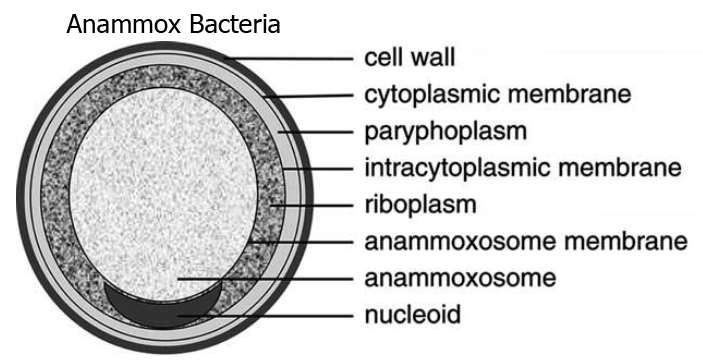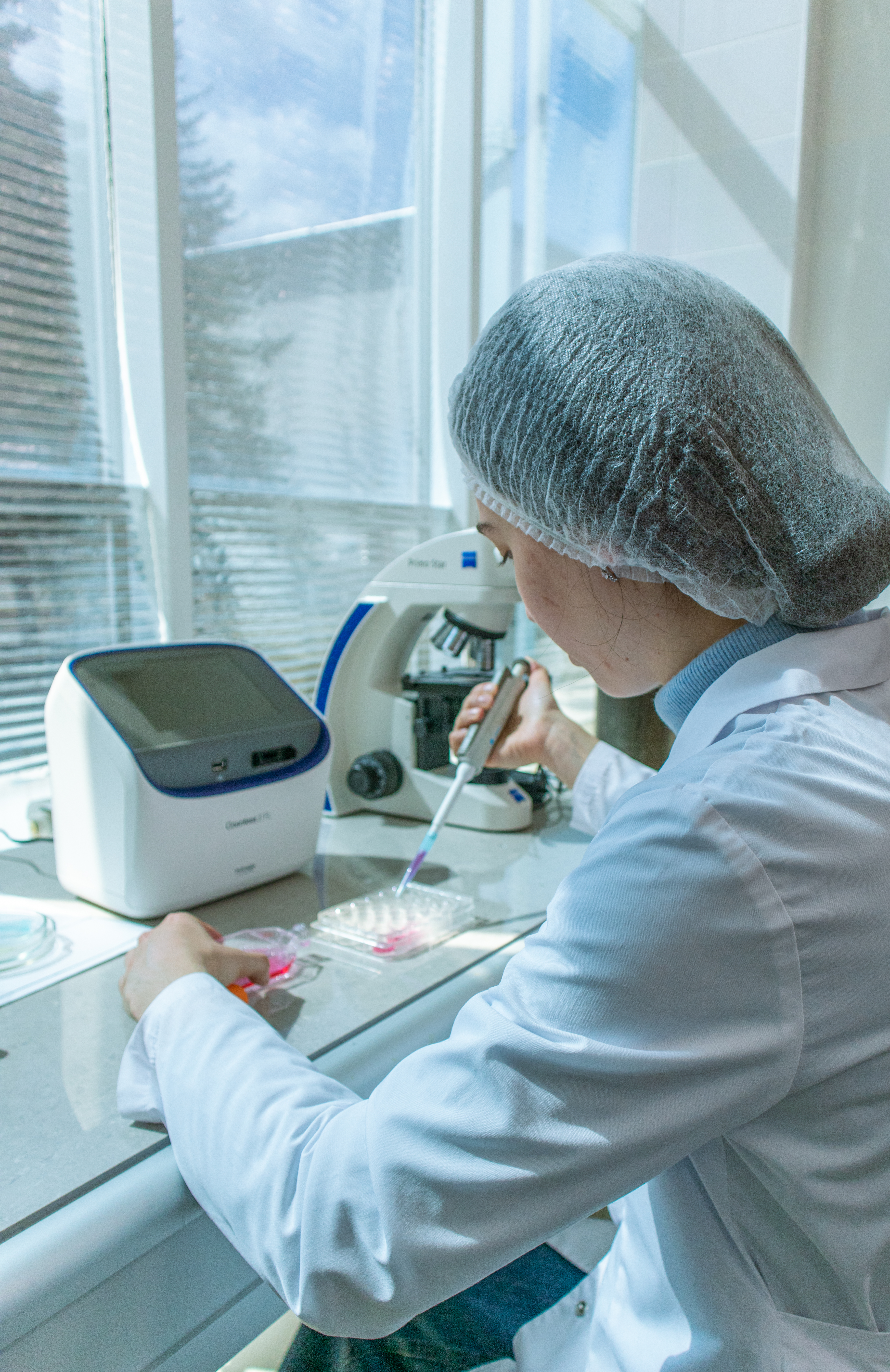|
Anammoxosome
Anammox, an abbreviation for "anaerobic ammonium oxidation", is a globally important microbial process of the nitrogen cycle that takes place in many natural environments. The bacteria mediating this process were identified in 1999, and were a great surprise for the scientific community. In the anammox reaction, nitrite and ammonium ions are converted directly into diatomic nitrogen and water. The bacteria that perform the anammox process are genera that belong to the bacterial phylum Planctomycetota. The anammox bacteria all possess one anammoxosome, a lipid bilayer membrane-bound compartment inside the cytoplasm in which the anammox process takes place. The anammoxosome membranes are rich in ladderane lipids; the presence of these lipids is so far unique in biology. "Anammox" is also the trademarked name for an anammox-based ammonium removal technology developedJetten Michael Silvester Maria, Van Loosdrecht Marinus Corneli; Technische Universiteit Delftpatent WO9807664/ref> by ... [...More Info...] [...Related Items...] OR: [Wikipedia] [Google] [Baidu] |
Ladderane Lipids Of Anammox Bacteria
In chemistry, a ladderane is an organic molecule containing two or more fused cyclobutane rings. The name arises from the resemblance of a series of fused cyclobutane rings to a ladder. Numerous synthetic approaches have been developed for the synthesis of ladderane compounds of various lengths. The mechanisms often involve + 2photocycloadditions, a useful reaction for creating strained 4-membered rings. Naturally occurring ladderanes have been identified as major components of the anammoxosome membrane of the anammox bacteria, phylum ''Planctomycetota''. Nomenclature Chain length Synthetic approaches have yielded ladderanes of varying lengths. A classification system has been developed to describe ladderanes based on the number of consecutive rings. The length of the ladderane is described by the number in brackets that precedes the word "ladderane". This is equal to the number of bonds shared by two cyclobutanes (''n'') plus 1. A ladderane of 3 or more units can connect ... [...More Info...] [...Related Items...] OR: [Wikipedia] [Google] [Baidu] |
Scalindua
"''Candidatus'' Scalindua" is a bacterial genus, and a proposed member of the order Planctomycetales. These bacteria lack peptidoglycan in their cell wall and have a compartmentalized cytoplasm. They are ammonium oxidizing bacteria found in marine environments. Introduction "''Candidatus'' Scalindua" is a bacterial genus, member of the order Planctomycetales. These bacteria lack peptidoglycan in their cell wall and have a compartmentalized cytoplasm. "''Candidatus'' Scalindua" spp. can be further divided into three species: Scalindua brodae, Scalindua wagneri, and Scalindua sorokinii. They are ammonium oxidising bacteria found in marine environments. The genus "''Ca.'' Scalindua" are the most abundant anammox bacteria in marine environments, so they are vital to the Earth's nitrogen cycle. Metabolism Members of the proposed genus Scalindua are anaerobic anammox (ammonium oxidizing) bacteria. The ammonium-oxidizing reaction composes a significant part of the global nitrogen ... [...More Info...] [...Related Items...] OR: [Wikipedia] [Google] [Baidu] |
Brocadia Anammoxidans
"''Candidatus'' Brocadia" is a '' candidatus'' genus of bacteria, meaning that while it is well-characterized, it has not been grown as a pure culture yet. Due to this, much of what is known about ''Candidatus'' species (including Brocadia) has been discovered using culture-independent techniques such as metagenomic sequence analysis. Some notable species within this genus include the type species, ''Candidatus'' Brocadia anammoxidans, along with ''Candidatus'' Brocadia sinica and ''Candidatus'' Brocadia fulgida. Many of the species in this genus, including those already listed, are capable of anaerobic ammonium oxidation, also known as anammox, an important part of the global nitrogen cycle. Anammox works by converting fixed nitrogen back into N2 gas in the atmosphere. Anammox bacteria have a unique, membrane-bound organelle where this anammox process takes place—it is called the anammoxosome. Phylogeny Phylogeny based on GTDB 09-RS220 by Genome Taxonomy Database Str ... [...More Info...] [...Related Items...] OR: [Wikipedia] [Google] [Baidu] |
Planctomycetota
The Planctomycetota are a phylum of widely distributed bacteria, occurring in both aquatic and terrestrial habitats. They play a considerable role in global carbon and nitrogen cycles, with many species of this phylum capable of anaerobic ammonium oxidation, also known as anammox. Many Planctomycetota occur in relatively high abundance as biofilms, often associating with other organisms such as macroalgae and marine sponges. Planctomycetota are included in the PVC superphylum along with Verrucomicrobiota, Chlamydiota, Lentisphaerota, Kiritimatiellaeota, and ''Candidatus'' ''Omnitrophica''. The phylum Planctomycetota is composed of the classes Planctomycetia and Phycisphaerae. First described in 1924, members of the Planctomycetota were identified as eukaryotes and were only later described as bacteria in 1972. Early examination of members of the Planctomycetota suggested a cell plan differing considerably from other bacteria, although they are now confirmed as Gram-negative ba ... [...More Info...] [...Related Items...] OR: [Wikipedia] [Google] [Baidu] |
Biotechnology
Biotechnology is a multidisciplinary field that involves the integration of natural sciences and Engineering Science, engineering sciences in order to achieve the application of organisms and parts thereof for products and services. Specialists in the field are known as biotechnologists. The term ''biotechnology'' was first used by Károly Ereky in 1919 to refer to the production of products from raw materials with the aid of living organisms. The core principle of biotechnology involves harnessing biological systems and organisms, such as bacteria, yeast, and plants, to perform specific tasks or produce valuable substances. Biotechnology had a significant impact on many areas of society, from medicine to agriculture to environmental science. One of the key techniques used in biotechnology is genetic engineering, which allows scientists to modify the genetic makeup of organisms to achieve desired outcomes. This can involve inserting genes from one organism into another, and con ... [...More Info...] [...Related Items...] OR: [Wikipedia] [Google] [Baidu] |
Nitrate
Nitrate is a polyatomic ion with the chemical formula . salt (chemistry), Salts containing this ion are called nitrates. Nitrates are common components of fertilizers and explosives. Almost all inorganic nitrates are solubility, soluble in water. An example of an insoluble nitrate is bismuth oxynitrate. Chemical structure The nitrate anion is the conjugate acid, conjugate base of nitric acid, consisting of one central nitrogen atom surrounded by three identically bonded oxygen atoms in a trigonal planar arrangement. The nitrate ion carries a formal charge of −1. This charge results from a combination formal charge in which each of the three oxygens carries a − charge, whereas the nitrogen carries a +1 charge, all these adding up to formal charge of the polyatomic nitrate ion. This arrangement is commonly used as an example of Resonance (chemistry), resonance. Like the isoelectronic carbonate ion, the nitrate ion can be represented by three resonance structures: Che ... [...More Info...] [...Related Items...] OR: [Wikipedia] [Google] [Baidu] |
Engelbert Broda
Engelbert Broda (29 August 1910, in Vienna – 26 October 1983) was an Austrian chemist and a suspected Soviet KGB operative with a codenamed: Eric, who could have been a main Russian source on the American-led Manhattan Project on the British side that may have accelerated and advanced the Soviet program of nuclear weapons.Leonard Doyle (10 May 2009)"New spy book names Engelbert Broda as KGB atomic spy in Britain" ''Daily Telegraph''Ben Macintyre (10 June 2009)"The spy who started the Cold War" ''The Times'' Early life Broda was born in Vienna on 29 August 1910 as the first son of Ernst and Viola Broda. His father, Ernst, a lawyer; his mother was a housewife. His younger brother Christian Broda was a lawyer who would later become a politician and serve as Minister of Justice in Austria. Broda was strongly influenced by his uncle Georg Wilhelm Pabst, a famous film director, and Egon Schönhof, who returned to Austria as a convinced communist after serving time as a prisoner-o ... [...More Info...] [...Related Items...] OR: [Wikipedia] [Google] [Baidu] |
Fermentation
Fermentation is a type of anaerobic metabolism which harnesses the redox potential of the reactants to make adenosine triphosphate (ATP) and organic end products. Organic molecules, such as glucose or other sugars, are catabolized and reduced by donating their electrons to other organic molecules (cofactors, coenzymes, etc.). Fermentation is important in several areas of human society. Humans have used fermentation in the production and preservation of food for 13,000 years. It has been associated with health benefits, unique flavor profiles, and making products have better texture. Humans and their livestock also benefit from fermentation from the microbes in the gut that release end products that are subsequently used by the host for energy. Perhaps the most commonly known use for fermentation is at an industrial level to produce commodity chemicals, such as ethanol and lactate. Ethanol is used in a variety of alcoholic beverages (beers, wine, and spirits) while lactate ... [...More Info...] [...Related Items...] OR: [Wikipedia] [Google] [Baidu] |
Dinitrogen
Nitrogen is a chemical element; it has symbol N and atomic number 7. Nitrogen is a nonmetal and the lightest member of group 15 of the periodic table, often called the pnictogens. It is a common element in the universe, estimated at seventh in total abundance in the Milky Way and the Solar System. At standard temperature and pressure, two atoms of the element bond to form N2, a colourless and odourless diatomic gas. N2 forms about 78% of Earth's atmosphere, making it the most abundant chemical species in air. Because of the volatility of nitrogen compounds, nitrogen is relatively rare in the solid parts of the Earth. It was first discovered and isolated by Scottish physician Daniel Rutherford in 1772 and independently by Carl Wilhelm Scheele and Henry Cavendish at about the same time. The name was suggested by French chemist Jean-Antoine-Claude Chaptal in 1790 when it was found that nitrogen was present in nitric acid and nitrates. Antoine Lavoisier suggested instea ... [...More Info...] [...Related Items...] OR: [Wikipedia] [Google] [Baidu] |








